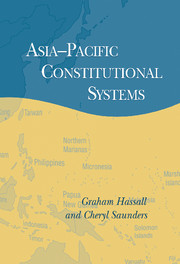Book contents
- Frontmatter
- Contents
- Acknowledgements
- Map: The Asia-Pacific Region
- Introduction
- Part I Modernity and Nation-States at the Dawn of the Global Era
- Part II The Constitution of Modernity
- Part III Democracy and the Rule of Law
- 8 Courts and the judiciary
- 9 The suspension of constitutional power
- 10 Devolution
- Conclusion: Postmodernity and constitutionalism
- Appendix: Chronology of constitutional events in the Asia Pacific
- Bibliography
- Index
8 - Courts and the judiciary
Published online by Cambridge University Press: 09 October 2009
- Frontmatter
- Contents
- Acknowledgements
- Map: The Asia-Pacific Region
- Introduction
- Part I Modernity and Nation-States at the Dawn of the Global Era
- Part II The Constitution of Modernity
- Part III Democracy and the Rule of Law
- 8 Courts and the judiciary
- 9 The suspension of constitutional power
- 10 Devolution
- Conclusion: Postmodernity and constitutionalism
- Appendix: Chronology of constitutional events in the Asia Pacific
- Bibliography
- Index
Summary
This chapter considers the powers and functions of courts, and the ways in which courts are established and staffed to conduct these functions. The judicial system of a country generally consists of a hierarchy of courts, including a Supreme or High Court, a court of appeal, and other courts established by the constitution or by parliament. Those states that have retained customary laws and authorities may also have lands and titles courts. Judicial review refers to the power of a court or other body to review the lawfulness of a law or an action by one or other branch of government. Such review is necessary since all constitutional systems require clarity as to what acts are constitutional, and which institutions are authorised to give a final determination on the constitutionality of a law or government action. While most constitutional systems include institutions and procedures to conduct judicial review, others do not. Judicial restraint on executive agencies of government is seen as essential to costitutional government. Courts, however, are generally empowered to consider matters of procedural justice, as opposed to substantive justice, which is the responsibility of the legislature and the government
Courts solve disputes by finding the relevant law, either from existing statutes or from 'common law'. In this way, courts can assist citizens who are in conflict with each other, or with a business, or with a branch of the government (and for this reason courts are regarded as the 'guardian of the people').
- Type
- Chapter
- Information
- Asia-Pacific Constitutional Systems , pp. 169 - 197Publisher: Cambridge University PressPrint publication year: 2002

